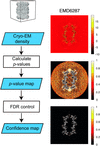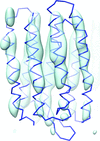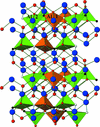issue contents
January 2019 issue

editorial
CRYO | EM
Cryo-EM has seen unabated growth and adoption in the last three years. Continued support at institutional, regional and national levels is essential to sustain its evolution.
scientific commentaries
CRYO | EM
Beckers et al. [IUCrJ (2019), 6, 18–33] propose a general approach to visualization of cryo-EM maps. Their method overcomes some of the challenges inherent in the conventional approach for depicting maps using a single isosurface threshold.
research papers
CRYO | EM
A Bayesian approach to estimate the trajectories of particle motion in electron cryo-microscopy single-particle analysis is presented.
CRYO | EM
The interpretation of cryo-EM density by atomic models remains a daunting task owing to the identification of appropriate threshold levels at low signal-to-noise ratios in high-resolution shells and weak structural features. It is shown that transforming cryo-EM densities to confidence maps followed by false discovery rate-based thresholding provides a robust way to interpret cryo-EM structures.
PHYSICS | FELS
Three-dimensional intensities were reconstructed from serial crystallography data using two-dimensional crystals.
BIOLOGY | MEDICINE
Two artificial β-propeller proteins with eight identical blades were designed, purified and crystallized. X-ray crystallography confirmed the perfectly symmetrical structures of these highly stable proteins.
CHEMISTRY | CRYSTENG
Download citation


Download citation


Low-temperature X-ray and neutron diffraction experiments are used to characterize the electron-density distribution and intermolecular interactions in the insoluble carbonate salt of a 2,6-pyridine-bis(iminoguanidine), a potential CO2 sequestering agent. The importance of the hydrogen-bonding ability of the cation to the anion–water structure is discussed.
CHEMISTRY | CRYSTENG
Download citation


Download citation


The synthesis and structure refinement of a dense zeolite with a one-dimensional channel system is reported.
CCDC reference: 1878958
PHYSICS | FELS
SPIND is an auto-indexing algorithm developed for sparse-pattern diffraction data. It is generally applicable to multiple crystallographic data types including serial crystallographic data collected from X-ray free-electron lasers (XFEL), synchrotron light sources or transmission electron diffraction data collected on a transmission electron microscope (TEM), and can also be extended to ultrafast electron diffraction data. The algorithm and comparative studies on experimental serial femtosecond protein crystallography data sets demonstrate its ability to maximize data efficiency by making use of sparse patterns that are discarded by other indexing programs.
CHEMISTRY | CRYSTENG
Download citation


Download citation


The effect of framework (pore) disorder on gas sorption of azole-based isoreticular Cu(II) MOFs with rtl (rutile) topology and characteristic 1D tubular pore channels is investigated for the first time.
CCDC reference: 945810
MATERIALS | COMPUTATION
This work provides a new theoretical approach based on group theory and graph theory to capture the intrinsic properties of crystalline materials upon deformation.
NEUTRON | SYNCHROTRON
Download citation


Download citation


The temperature evolution of [CH3NH3][Co(COOH)3] on a single crystal and the crystal structure determination of intermediate incommensurate phases of [CH3NH3][Co(COOH)3] by means of neutron diffraction are presented.
B-IncStrDB reference: 13542El8AS4
MATERIALS | COMPUTATION
The defect structure of γ-Al2O3 produced from boehmite is described with the aid of antiphase and rotational boundaries. The type of structure defects is deduced from the selected-area electron-diffraction patterns. The defect density is quantified from the anisotropic broadening of diffraction lines in powder X-ray diffraction patterns using a computer routine based on the Debye scattering equation.
CHEMISTRY | CRYSTENG
Download citation


Download citation


The success and effects of fluorination on the starting Ln4(Al2O7□)O2 (Ln = Sm, Eu, Gd) cuspidine-related structure were investigated. The incorporation of fluoride in this structure resulted in the conversion of the isolated tetrahedral dialuminate Al2O7 groups to chains of distorted square-based pyramids.
MATERIALS | COMPUTATION
Download citation


Download citation


A phase transition in a jumping crystal is predicted using molecular dynamics. The resulting structure and the dynamics of the transition are verfied by TLS refinement against powder diffraction data.
CCDC reference: 1867396
CHEMISTRY | CRYSTENG
Download citation


Download citation


The under-oil crystallization method was successfully adopted for the crystallization of organic salts. Compared with the previously reported vapour-diffusion-based nano-crystallization technique, the under-oil method generated single crystals of more different salts for all studied compounds.



 journal menu
journal menu




 access
access





























